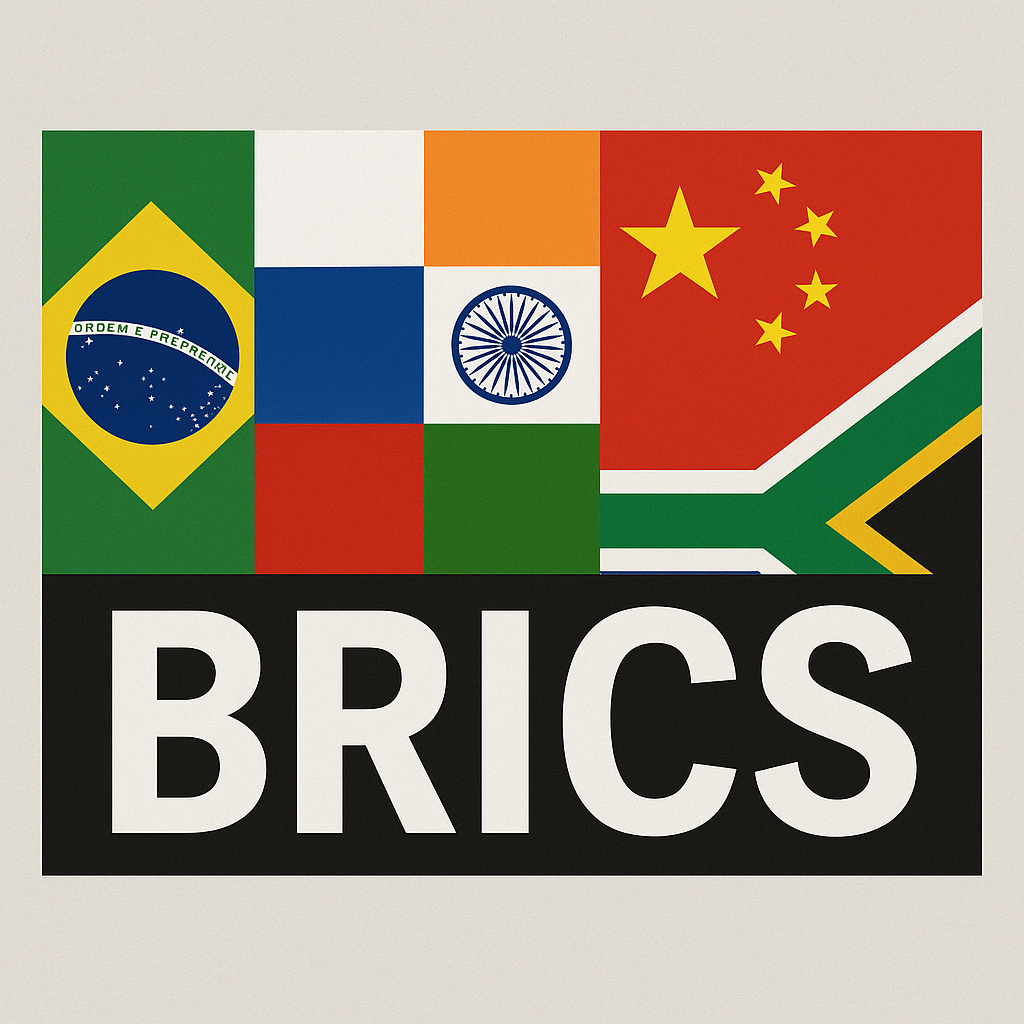BRICS: A Rising Power Bloc Shaping the New World Order
Introduction
BRICS is an acronym for Brazil, Russia, India, China, and South Africa, representing a coalition of five major emerging economies. Together, these nations aim to reform global governance, enhance south-south cooperation, and create a more balanced multipolar world. BRICS accounts for over 40% of the world’s population, nearly 30% of global GDP, and about 25% of the world’s land area. More than just an economic bloc, BRICS has grown into a political and strategic force challenging the traditional dominance of Western-led institutions.
Origin and Evolution of BRICS
The Coining of “BRIC”
The term “BRIC” was first coined in 2001 by Jim O’Neill, an economist at Goldman Sachs. In his research paper, “Building Better Global Economic BRICs,” he predicted that Brazil, Russia, India, and China would become dominant suppliers of manufactured goods, services, and raw materials by 2050.
Formation and Expansion
- 2006: The foreign ministers of Brazil, Russia, India, and China held their first informal meeting on the sidelines of the UN General Assembly.
- 2009: The first BRIC summit was held in Yekaterinburg, Russia.
- 2010: South Africa was officially invited and joined the group, turning BRIC into BRICS.
- Since then, BRICS has held annual summits, rotating host countries, and has expanded its agenda far beyond economics.
Objectives of BRICS
BRICS was founded on shared interests in reforming global institutions and creating a more equitable world order. Its core objectives include:
1. Reforming Global Governance
BRICS seeks to restructure global financial and political institutions such as the United Nations, IMF, and World Bank to give greater representation to developing countries.
2. Promoting Multilateralism
The group supports a multipolar world, where power is not concentrated in the hands of a few Western countries but is distributed more evenly among various global players.
3. Economic Cooperation
BRICS promotes trade, investment, innovation, and sustainable development among its member states, aiming to reduce dependence on the West.
4. South-South Cooperation
Enhancing collaboration among developing countries, especially in areas like technology transfer, infrastructure development, and capacity building.
Member Countries: Profiles and Contributions
1. Brazil
A leading economy in Latin America, Brazil is rich in natural resources, especially agriculture and biofuels. It plays a significant role in climate policy and food security.
2. Russia
Russia brings in strategic military power, vast energy reserves, and global influence, especially in Eurasian geopolitics. It is a major supplier of oil, gas, and defense equipment.
3. India
India contributes with its demographic advantage, digital innovation, and strong service sector. It’s the world’s largest democracy and a rising tech hub.
4. China
As the world’s second-largest economy, China is central to BRICS. Its manufacturing might, infrastructure investments, and global trade leadership give the group significant economic clout.
5. South Africa
South Africa provides a gateway to the African continent. As Africa’s most industrialized nation, it enhances BRICS’ reach and relevance in Africa.
Key BRICS Institutions and Initiatives
BRICS has created several multilateral institutions to promote economic and financial cooperation, independent of Western-dominated systems:
1. New Development Bank (NDB)
- Established in 2014, headquartered in Shanghai.
- Provides funding for infrastructure and sustainable development projects in BRICS and other developing nations.
- Seen as an alternative to the World Bank.
2. Contingent Reserve Arrangement (CRA)
- A framework to offer liquidity support to members facing balance-of-payments crises.
- Acts as a financial safety net, reducing reliance on the IMF.
3. BRICS Business Council
- Promotes trade and investment between member nations.
- Bridges the gap between public policy and the private sector.
4. BRICS Think Tank Council
- A platform for academic and policy research that supports BRICS goals.
- Encourages intellectual exchange and cooperation.
Key Achievements of BRICS
- Created a new financial architecture independent of Western systems (e.g., NDB).
- Increased intra-BRICS trade, which now stands at over $400 billion annually.
- Launched various joint ventures in science, education, space exploration, and technology.
- Advocated for climate action, including coordinated positions at COP summits.
- Actively discussed reforming the UN Security Council to include India and others.
Recent Developments: BRICS Expansion (2023-2024)
At the 2023 Johannesburg Summit, BRICS invited six new countries to join: Argentina, Egypt, Ethiopia, Iran, Saudi Arabia, and the UAE. This expansion marked a historic shift:
- Diversified the group politically and economically.
- Strengthened the bloc’s energy dominance (with Saudi Arabia, UAE, Iran).
- Increased representation from Africa and the Middle East.
While Argentina later opted out due to political changes, the expansion is ongoing, and more countries have expressed interest.
Challenges Facing BRICS
Despite its successes, BRICS faces several internal and external challenges:
1. Geopolitical Tensions
- India-China border disputes.
- Russia’s invasion of Ukraine causing global polarization.
2. Economic Imbalances
- China dominates the group economically, creating concerns among other members about influence and decision-making.
3. Institutional Weaknesses
- Unlike the EU or NATO, BRICS lacks a formal charter or secretariat.
- Decision-making is consensus-based, often slowing progress.
4. Divergent Political Systems
- Members have vastly different political ideologies, governance models, and foreign policy priorities.
BRICS vs G7: A Counterweight?
The G7 (Group of Seven) represents advanced industrialized nations (like the US, UK, France, etc.), while BRICS aims to represent the Global South.
| Criteria | G7 | BRICS |
|---|---|---|
| Members | 7 developed nations | 5+ emerging economies |
| GDP (combined) | ~44% of global GDP | ~30% and rising |
| Focus | Western liberal order | Multipolar, non-Western order |
| Structure | Institutionalized | Flexible, less formal |
Many see BRICS as a strategic counterbalance to Western dominance, especially in financial and diplomatic institutions.
Future Outlook
1. Toward a BRICS Currency?
There have been discussions about creating a common BRICS currency to challenge the dominance of the US dollar in international trade. While still in early stages, it reflects a desire for financial sovereignty.
2. Greater Global Role
BRICS aims to have a stronger voice in global decisions, particularly on climate change, digital governance, and AI regulation.
3. Enhanced Digital and Tech Cooperation
Members are investing in joint digital infrastructure, cross-border payments systems, and AI collaboration.
4. Expanded Membership
As more countries express interest, BRICS may evolve into BRICS+, possibly forming a global alliance of the Global South.
Conclusion
BRICS represents a shift in global power. While not without internal differences, it reflects a collective desire to reform existing global structures, reduce dependence on the West, and build a more just, inclusive, and multipolar world order.
As BRICS continues to grow and evolve, it may well become a central pillar in the 21st-century geopolitical and economic landscape — not as a replacement for the current world order, but as a necessary rebalancing of it.


